

-
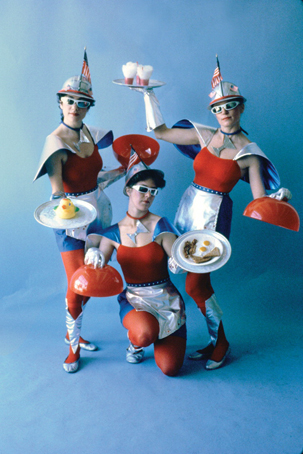
The Waitresses Easy Three-Step Guide to Food Protection in the Event of Nuclear Attack (This Piece by Anne Gaulke, Chutney Gunderson, Anne Mavor, and Denise Yarfiz) (1982-83)
The Waitresses
Jerri Allyn and Anne Gauldin formed The Waitresses in 1977. This collaborative performance art group was made up of artists who were waitresses. Graduates of the Feminist Studio Workshop at the Woman’s Building, they humorously entertained audiences while focusing a critical eye on working conditions for women. The 1970s was a challenging time for women in the workplace: sexual harassment was not part of the consciousness or legal system. The Waitresses performed in restaurants and other public spaces to raise awareness about women and money, waitress stereotypes, women and work, and sexual harassment on the job.
Performance art
Part of the Woman's Building Image Archive at Otis College of Art and Design, Courtesy of the Waitresses. Photograph by Joyce Dallal © The Waitresses -

Poster for Women in Design Conference (1975)
Sheila Levrant de Bretteville
This diazo print advertising the Women in Design conference held in 1975 at the Woman’s Building features Sheila Levrant de Bretteville’s signature eyebolt. According to de Bretteville the eyebolt was a symbol for “strength without a fist.” The eyebolt was made into a necklace and every conference attendee was given one to wear as a ticket to the event. The overall image of the poster is meant to represent a dialogue among women amongst the grid. Listen to Shelia Levrant de Bretteville at http://www.youtube.com/watch?v=AGJUbYc5O98&feature=relmfu.
Diazo print Approximately 11 x 17 in
Part of the Woman's Building Image Archive at Otis College of Art and Design © Sheila Levrant de Bretteville -
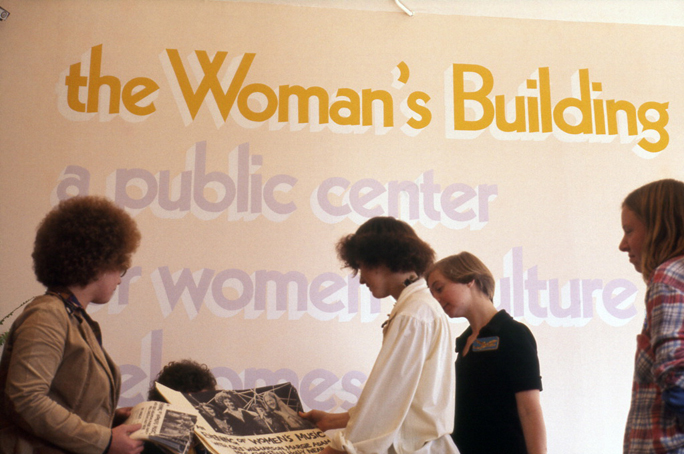
Photograph of the Entry Hall of the Woman's Building (1976)
Artist Unknown
"The Woman’s Building—a public center for women’s culture—Welcomes you!” The Woman’s Building welcomed women through its door in 1973, enticing them with art, culture, and community. At the WB you could join the Feminist Studio Workshop, take a class, or attend a performance, reading, or gallery exhibition. It was a place to gain artistic skills like printmaking, film editing, or writing, while also learning practical skills such as basic construction or car repair. It encouraged and empowered women to make art about their experience.
Photograph
Part of the Woman's Building Image Archive at Otis College of Art and Design © The Woman's Building -
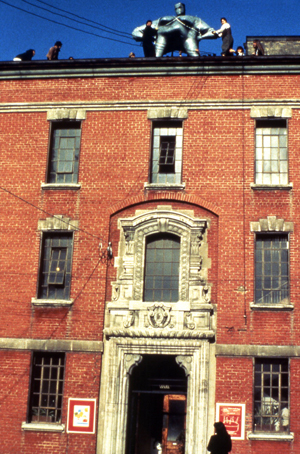
Great Lady Rising Event (1978)
Kate Millett
Kate Millett, artist and author of Sexual Politics (New York: Doubleday, 1970), was an artist-in-residence at the Woman’s Building in 1977. While she was there, she worked with members of the WB to make a large collection of giant papier-mâché sculptures of women, called the Great Ladies. In 1978, to celebrate the Fifth Anniversary of the Woman’s Building, one of these mythic women was hoisted to the top of the building and installed on the ledge as part of a performance/media event called Great Lady Rising.
Documentary photograph
Part of the Woman's Building Image Archive at Otis College of Art and Design © The Woman's Building -
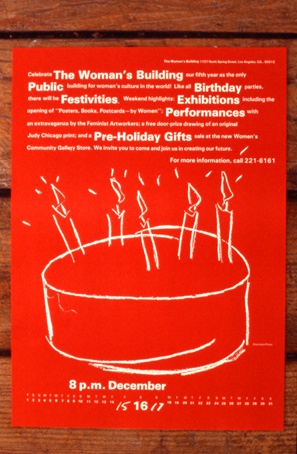
Poster for the Fifth Anniversary of the Woman's Building (1978)
Angeline Pike
In 1978, the Woman’s Building celebrated its fifth anniversary in Los Angeles as the only independent feminist cultural institution in the world. This commemorative poster was designed by Sheila Levrant de Bretteville (WB founding mother) and features a drawing by Phranc, the All-American Jewish lesbian folksinger.
Offset printing 10 x 13 in
Part of the Woman's Building Image Archive at Otis College of Art and Design © The Woman's Building -
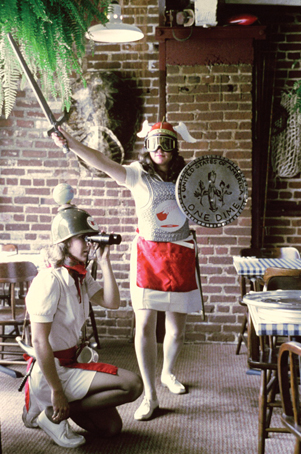
Making It Safe (This Piece by Anne Gauldin, Chutney Gunderson, Anita Green) (1979)
The Waitresses
Jerri Allyn and Anne Gauldin formed The Waitresses in 1977. This collaborative performance art group was made up of artists who were waitresses. Graduates of the Feminist Studio Workshop at the Woman’s Building, they humorously entertained audiences while focusing a critical eye on working conditions for women. The 1970s was a challenging time for women in the workplace: sexual harassment was not part of the consciousness or legal system. The Waitresses performed in restaurants and other public spaces to raise awareness about women and money, waitress stereotypes, women and work, and sexual harassment on the job.
Performance art piece; a part of Ariadne's Making It Safe project
Part of the Woman's Building Image Archive at Otis College of Art and Design, Courtesy of the Waitresses. Photograph by Charles Grimes © The Waitresses -
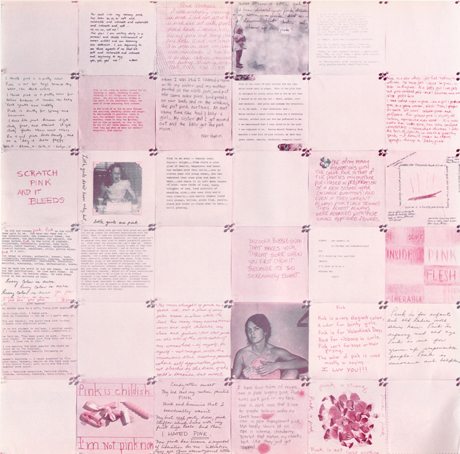
Pink (1974)
Sheila Levrant de Bretteville
In 1973 Sheila Levrant de Bretteville, designer and founding mother of the Woman’s Building, was invited by the American Institute of Graphics Arts to create a 30-inch work based on a color of her choosing. De Bretteville chose pink in an effort to liberate the color, and women too, from predetermined meanings of that hue. She divided up her 30 inches into square pieces of pink paper, and gave the squares to women at the Woman’s Building and people in the streets of all ages to share stories, ideas, and words about the color pink. After collecting all the responses, she assembled the papers and pinned them to a board with map tacks. The work was reproduced as a poster that was part of a New York fundraiser and then was sold at the Sisterhood Bookstore at the Woman’s Building, wheat-pasted in the streets of Echo Park and Silver Lake, and given away as gifts.
Offset printing 20 x 20 in
Created by Sheila Levrant de Bretteville with women of the Feminist Studio Workshop for an exhibition about color. Part of the Woman's Building Image Archive at Otis College of Art and Design © Sheila Levrant de Bretteville -
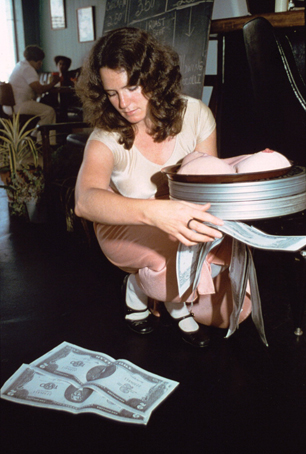
Ready to Order? (Jerri Allyn, Anne Gauldin [pictured], Leslie Belt, Jamie Wildman, Patti Nicklaud, and Denise Yarfiz) (1978)
The Waitresses
Jerri Allyn and Anne Gauldin formed The Waitresses in 1977. This collaborative performance art group was made up of artists who were waitresses. These graduates of the Feminist Studio Workshop at the Woman’s Building humorously entertained audiences while focusing a critical eye on working conditions for women. The 1970s was a challenging time for women in the work place. Sexual harassment was not part of the consciousness or legal system. The Waitresses performed in restaurants and other public spaces to raise awareness about women and money, waitress stereotypes, women and work, and sexual harassment on the job. Hear The Waitresses tell their story at http://www.youtube.com/watch?v=xEn1djs4lI8&feature=related.
Conceptual and performance art
Part of the Woman's Building Image Archive at Otis College of Art and Design, courtesy of the Waitresses, Photograph by Maria Karras © The Waitresses -

First Woman's Building Brochure (1974)
Sheila Levrant de Bretteville
The Woman’s Building was the first independent feminist cultural institution in the world and women came rushing in! The WB housed the Feminist Studio Workshop, Extension Program, the Summer Art Program, the Woman’s Graphic Center, the Woman’s Switchboard, Womantours, Sisterhood Bookstore, and seven galleries all dedicated to showing art made by women. Sheila Levrant de Bretteville, designer and founding mother of the WB, designed this poster to promote all aspects of the newly founded organization residing in the old Chouinard Art Institute building located at 743 S. Grandview in downtown Los Angeles.
Offset printing 10 x 20 in
Part of the Woman's Building Image Archive at Otis College of Art and Design © The Woman's Building -
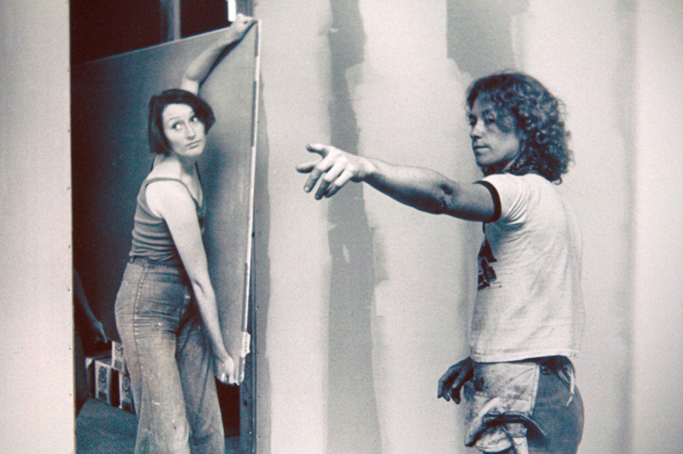
Sheila Levrant de Bretteville and Suzanne Lacy Moving Sheet Rock (1975)
Photographer Unknown
One of the core activities of a feminist art education is the building of a female context and environment. The Woman’s Building founders, faculty, students, and members literally remodeled the old Chouinard Art Institute building located at 743 S. Grandview in downtown Los Angeles, by building out classrooms, studios, workshops, gallery spaces, and common areas. Everyone learned how to build a wall and here, faculty member and artist, Suzanne Lacy, guides founder and designer, Sheila Levrant de Bretteville, to where the drywall needed to be placed. The students didn’t know when they signed up for the first year of the Feminist Studio Workshop that constructing their space would be part of the curriculum, but many say it was an empowering and important part of their education.
Documentary photograph
Part of the Woman's Building Image Archive at Otis College of Art and Design © The Woman's Building -
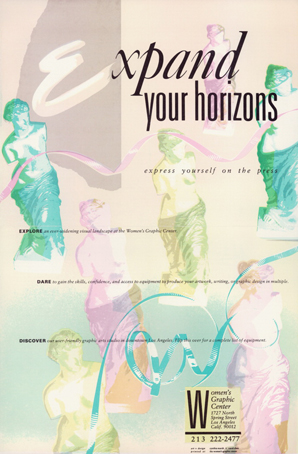
Expand Your Horizons: Poster to Advertise the Woman's Graphic Center Educational Program (1980)
Cynthia Marsh
Cynthia Marsh designed this poster to advertise the offerings of the Woman’s Graphic Center (WGC), which was an integral part of the Woman’s Building’s educational program. Women learned the processes of offset printing and letterpress, and experimented with new types of printing processes. Marsh was on faculty at the Woman's Building in Los Angeles from 1973 to 1978. She brought a process-oriented, painterly additive approach to printing in the designs she created and in the classes she taught. This innovative style informed her personal and commercial work, including her cover design for the Go-Go’s debut album, Beauty and the Beat (1981).
Offset printing 10 x 15 in
Part of the Woman's Building Image Archive at Otis College of Art and Design © The Woman's Building -

Yakkity Yak (Part of a Series of Posters Commissioned by the Woman's Building, Life in L.A.) (1983)
Carrie Mae Weems
Carrie Mae Weems created this image of Venice Beach in 1983 as part of the Posters about Life in L.A. project. Sheila Levrant de Bretteville of the Women’s Graphic Center, with Josine Ianco Starrels, invited ten women artists to make posters about public places in Los Angeles. Each artist chose a setting that evoked a connection and memory as personal and vivid as objects in a familiar private space. This project was funded by grants from the National Endowment for the Arts, a federal agency.
Offset print 18 x 24 in
Part of the Woman's Building Image Archive at Otis College of Art and Design © Carrie Mae Weems, the Woman's Building -

Arlene Raven, Close Up, a Photo from the First Feminist Studio Brochure (1973)
Photographer Unknown
Artist Judy Chicago, designer Sheila Levrant de Bretteville, and art historian Arlene Raven met as faculty at California Institute of the Arts (CalArts) in the early 1970s. By fall 1973 they left CalArts to form the Feminist Studio Workshop and to open the Woman’s Building—a public center for women’s culture. This photographic series of the WB founders is from the first brochure describing the Feminist Studio Workshop.
Offset printing
Part of the Woman's Building Image Archive at Otis College of Art and Design © The Woman's Building -
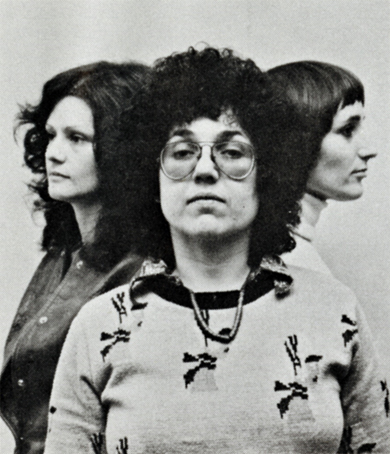
Judy Chicago, Close Up, a Photo from the First Feminist Studio Brochure (1973)
Photographer Unknown
Artist Judy Chicago, designer Sheila Levrant de Bretteville, and art historian Arlene Raven met as faculty at California Institute of the Arts in the early 1970s. By fall 1973 they left CalArts to form the Feminist Studio Workshop and to open the Woman’s Building—a public center for women’s culture. This photographic series of the WB founders is from the first brochure describing the Feminist Studio Workshop. From left to right: Arlene Raven, Judy Chicago, Sheila Levrant de Bretteville.
Offset Printing
Part of the Woman's Building Image Archive at Otis College of Art and Design © The Woman's Building -
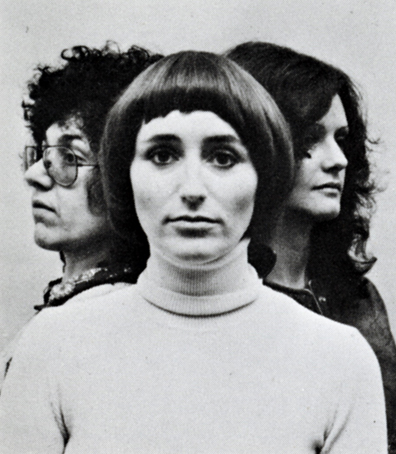
Sheila Levrant de Bretteville, Close Up, a Photo from the First Feminist Studio Brochure (1973)
Photographer Unknown
Artist Judy Chicago, designer Sheila Levrant de Bretteville, and art historian Arlene Raven met as faculty at California Institute of the Arts (CalArts) in the early 1970s. By fall 1973 they left CalArts to form the Feminist Studio Workshop and to open the Woman’s Building—a public center for women’s culture. This photographic series of the WB founders is from the first brochure describing the Feminist Studio Workshop. From left to right: Judy Chicago, Sheila Levrant de Bretteville, and Arlene Raven.
Offset Printing
Part of the Woman's Building Image Archive at Otis College of Art and Design © The Woman's Building -

Art and Handicraft of the Woman's Building (Cover and/or Frontpiece of the Catalogs Published for the Woman's Building at the Chicago World's Fair (1893)
Madeleine Lemaire
Art and Handicraft in the Woman’s Building was published as a catalog of the work exhibited in the Woman’s Building, designed by architect Sophia Hayden, as part of the Chicago World’s Fair of 1893. Artist Nancy Youdelman found a copy of this book in the early seventies when she was searching for props for the landmark installation project Womanhouse. This discovery was startling and amazing to the women of the Feminist Art Project at CalArts, because it was a forgotten, discarded history of women artists. Later, in 1973 when Judy Chicago, Arlene Raven, and Sheila Levrant de Bretteville left CalArts to found the Feminist Studio Workshop, the Woman’s Building built in 1893 inspired them to name and create their own Woman’s Building in downtown Los Angeles, dedicated to women’s culture.
Book cover, offset printing
Part of the Woman's Building Image Archive at Otis College of Art and Design -
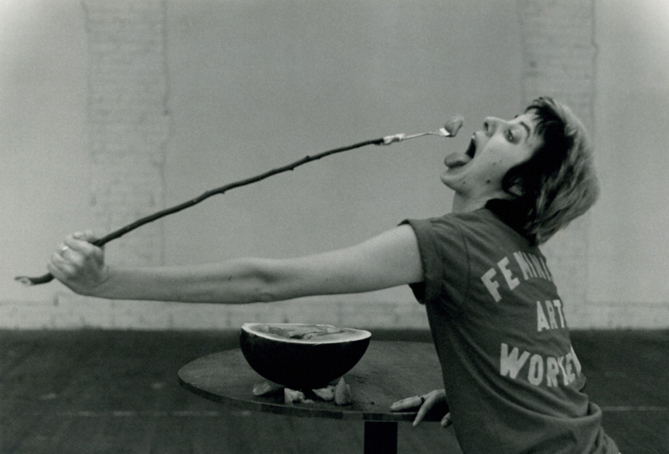
Heaven or Hell? (Cheri Gaulke Pictured) (1981)
Feminist Art Workers
Heaven or Hell was first performed in 1981. Nancy Angelo shared a story with the group that her grandmother told her about the difference between Heaven and Hell: “In Hell, a long banquet table is piled high with sumptous food and all the people are desperatley trying to feed themselves with four-foot-long forks. Heaven is exactly the same scene—the long banquet table and the sumptous meal. The difference is that in Heaven, people are using four-foot-long forks to feed each other.” For the performance, Feminist Art Workers (FAW) members along with the audience used four-foot-long forks to feed each other. The invitation read, “Feminists, artists, political workers. Arm yourselves with four-foot-long forks. Create opportunities to feed one another in a symbolic gesture. We, Feminist Art Workers, give this performance to you. As you go out and affect the world, take with you our support, appreciation, and encouragement to keep nurturing and inspiring one another. For it is our ability to sustain each other that will enable our political movements to endure.”
Performance Art
Part of the Woman's Building Image Archive at Otis College of Art and Design, Courtesy of Feminist Art Workers © Feminist Art Workers (Nancy Angelo, Candice Compton, Cheri Gaulke, Vanalyne Green, Laurel Klick) -
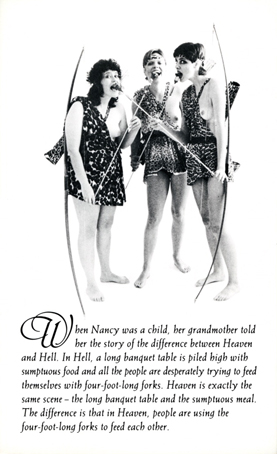
Heaven or Hell? (1981)
Feminist Art Workers
Feminist Art Workers (FAW) is a collaborative performance art group incorporating techniques of feminist education into participatory performance structures. FAW was founded in 1976 by Nancy Angelo, Candace Compton, Cheri Gaulke, and Laurel Klick. Compton left the group shortly thereafter and Vanalyne Green joined in 1978. Heaven or Hell was first performed in 1981. Nancy Angelo shared a story with the group that her grandmother told her about the difference between Heaven and Hell: “In Hell, a long banquet table is piled high with sumptous food and all the people are desperatley trying to feed themselves with four-foot-long forks. Heaven is exactly the same scene—the long banquet table and the sumptous meal. The difference is that in Heaven , people are using four-foot-long forks to feed each other.” Listen to FAW tell their story: http://www.youtube.com/watch?v=eWSNY-_KWJA.
Postcard front, offset printing 4 x 6 in
Part of the Woman's Building Image Archive at Otis College of Art and Design, Courtesy of Feminist Art Workers © Feminist Art Workers (Nancy Angelo, Candice Compton, Cheri Gaulke, Vanalyne Green, Laurel Klick) -
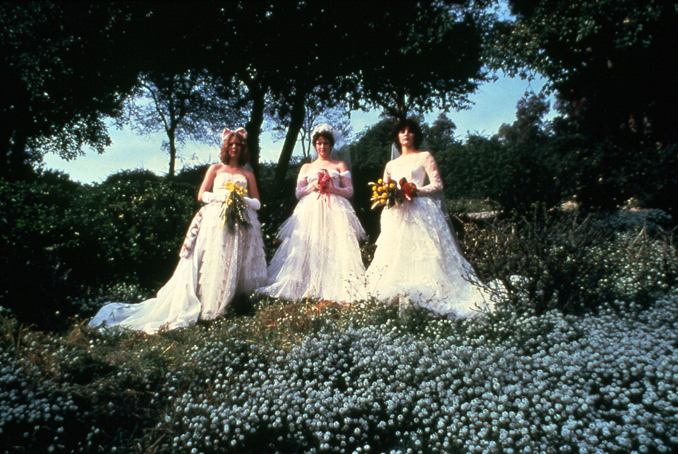
To Love, Honor, Cherish (1978)
Feminist Art Workers
Feminist Art Workers (FAW) is a collaborative performance art group incorporating techniques of feminist education into participatory performance structures. Its members met as participants in the educational programs at the Woman’s Building. FAW was founded in 1976 by Nancy Angelo, Candace Compton, Cheri Gaulke, and Laurel Klick. Compton left the group shortly thereafter and Vanalyne Green joined in 1978. To celebrate the Fifth Anniversary of the Woman’s Building, three members of FAW decided to marry the Woman's Building. Hear the Feminist Art Workers tell their story: http://www.youtube.com/watch?v=eWSNY-_KWJA">http://www.youtube.com/watch?v=eWSNY-_KWJA.
Publicity still from performance for the Fifth Anniverasry of the Woman's Building
Part of the Woman's Building Image Archive at Otis College of Art and Design, Courtesy of Feminist Art Workers © Feminist Art Workers (Nancy Angelo, Candice Compton, Cheri Gaulke, Vanalyne Green, Laurel Klick) -

Laundry Works (1974)
Mother Art
Offset printing poster
Part of the Woman's Building Image Archive at Otis College of Art and Design, Courtesy of Mother Art. Photo: Helen Ruby © Mother Art, 1974, 2010 -
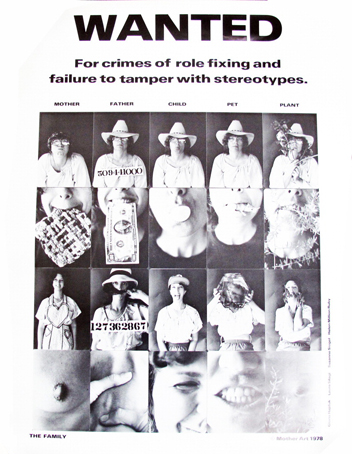
Laundry Works, Poster Advertising Performances (1974)
Mother Art
Oddset printing
Part of Woman's Building Image Archive at Otis College of Art and Design, Courtesy of Mother Art. Photograph by Mother Art © Mother Art 1978, 2010 -
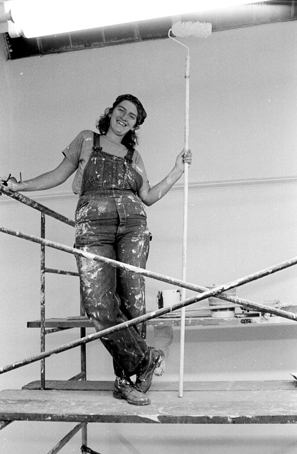
Susan King Painting the Walls of the Woman's Building (1973)
Susan Mogul
Documentary photo
Part of the Woman's Building Image Archive at Otis College of Art and Design © The Woman's Building
Otis College of Art and Design, Ben Maltz Gallery
Doin' It in Public: Feminism and Art at the Woman's Building
Founded in 1973 by artist Judy Chicago, graphic designer Sheila Levrant de Bretteville, and art historian Arlene Raven, the Woman's Building was a space for artistic, social, pedagogical, and political experimentation and provided a multi-faceted community in which innovation was supported. The exhibition, catalogue, and supporting public events will document, contextualize and pay tribute to the groundbreaking work of feminist artists and art cooperatives that were centered in and around the Woman's Building in the 1970s and 1980s, and highlight the institution's importance to the development of the Los Angeles art scene.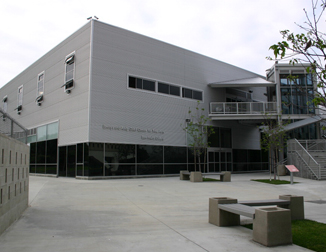
Los Angeles, CA 90045





















